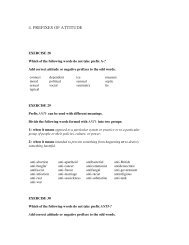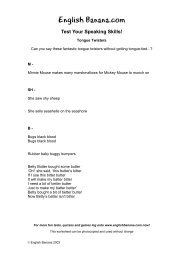Direct and Indirect Speech - ESL Teachers Board
Direct and Indirect Speech - ESL Teachers Board
Direct and Indirect Speech - ESL Teachers Board
- No tags were found...
Create successful ePaper yourself
Turn your PDF publications into a flip-book with our unique Google optimized e-Paper software.
The reason for changing "le lo" to "se lo" is merely to avoid the tongue-twisting effect of twoshort consecutive words that begin with the letter "l". To demonstrate this, first quickly say"les las" <strong>and</strong> then quickly say "se las." See how much easier it is to say "se las?"In negative sentences, the negative word comes directly before the first pronoun.No se lo tengo.I don't have it for you.Nunca se los compro.I never buy them for her.Because the pronoun se can have so many meanings, it is often helpful to clarify it by using aprepositional phrase.Él se lo dice.Ambiguous. He tells it to (whom?).Él se lo dice a Juan.He tells it to him. (to Juan)Él se lo dice a María.He tells it to her. (to María)Él se lo dice a ella.He tells it to her.In sentences with two verbs, there are two options regarding the placement of the pronouns.Place them immediately before the conjugated verb or attach them directly to the infinitive.She should explain it to me.Ella me lo debe explicar.Ella debe explicármelo.I want to tell it to you.Te lo quiero decir.Quiero decírtelo.You need to send it to them.Se la necesitas enviar a ellos.Necesitas enviársela a ellos.Note that when attaching the pronouns to the infinitive, a written accent is also added to thefinal syllable of the infinitive. This preserves the sound of the infinitive.
















